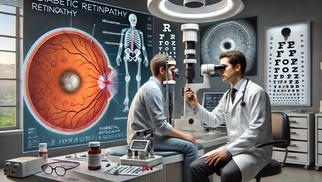Diabetic Retinopathy: Understanding the Condition, Its Stages, and Treatment Options


Diabetic retinopathy is a serious eye condition that affects individuals with diabetes, potentially leading to vision impairment and even blindness if left untreated. As diabetes becomes more prevalent worldwide, understanding its complications, including diabetic retinopathy, is crucial for early detection and management. This article explores the nature of diabetic retinopathy, its progression through four distinct stages, the possibility of halting or reversing the condition, the impact of type 2 diabetes on eye health, and the role of Tricor in its treatment.
What is Diabetic Retinopathy?
Diabetic retinopathy is a complication of diabetes that affects the blood vessels of the retina, the light-sensitive tissue at the back of the eye. Over time, high blood sugar levels can cause damage to these small blood vessels, leading to leakage, swelling, and abnormal vessel growth. The condition develops gradually and often remains asymptomatic in the early stages, making regular eye exams crucial for early detection. If left unmanaged, diabetic retinopathy can result in severe vision loss and blindness.
The primary cause of diabetic retinopathy is prolonged exposure to high glucose levels, which weakens and damages the blood vessels in the retina. Other contributing factors include high blood pressure, high cholesterol, and genetic predisposition. The condition can affect anyone with type 1 or type 2 diabetes, and the risk increases with the duration of diabetes and poor glycemic control.
The Four Stages of Diabetic Retinopathy
Diabetic retinopathy progresses through four stages, each representing increasing severity and potential vision impairment.
In the mild nonproliferative stage, small areas of swelling, known as microaneurysms, appear in the blood vessels of the retina. These microaneurysms may leak fluid, but at this stage, vision is usually not affected, and the condition is often detected only during an eye examination.
As the disease advances to the moderate nonproliferative stage, blood vessels supplying the retina begin to deteriorate, leading to poor blood flow and the accumulation of fluid in the retina. This can result in mild to moderate vision changes. Swelling in the macula, the central part of the retina responsible for sharp vision, can occur, a condition known as diabetic macular edema (DME).
The severe nonproliferative stage marks a more significant reduction in blood supply to the retina, prompting the release of growth factors that signal the formation of new, fragile blood vessels. The risk of retinal hemorrhages and vision impairment increases substantially at this stage.
In the proliferative stage, the most advanced phase of diabetic retinopathy, new abnormal blood vessels grow on the surface of the retina and into the vitreous, the gel-like substance inside the eye. These vessels are prone to rupturing, leading to bleeding, scar formation, and retinal detachment, which can cause severe vision loss or blindness. Without immediate medical intervention, vision loss at this stage can be irreversible.
Can Diabetic Retinopathy Be Stopped?
While diabetic retinopathy is a progressive condition, its advancement can be slowed or even halted with proper management. The key to preventing or delaying the onset of severe diabetic retinopathy lies in maintaining good blood sugar control. Studies have shown that keeping blood glucose levels within target ranges can significantly reduce the risk of developing diabetic eye disease.
Blood pressure and cholesterol management also play a vital role in controlling the progression of diabetic retinopathy. High blood pressure can exacerbate retinal damage, while elevated cholesterol levels contribute to the accumulation of fatty deposits in the blood vessels, further impairing retinal function. Lifestyle modifications, including a healthy diet, regular exercise, and smoking cessation, are essential for overall diabetes management and eye health preservation.
Early detection through regular eye examinations allows for timely intervention. Treatment options, such as laser therapy, anti-VEGF injections, and, in some cases, vitrectomy surgery, can help manage the condition and preserve vision. Therefore, while diabetic retinopathy cannot always be completely stopped, proactive management can significantly reduce its impact.
How Does Type 2 Diabetes Affect the Eyes?
Type 2 diabetes affects the eyes in multiple ways, with diabetic retinopathy being one of the most severe complications. Prolonged high blood sugar levels can damage the delicate blood vessels of the retina, leading to leakage and the formation of abnormal new vessels, which ultimately compromise vision. However, diabetic retinopathy is not the only eye problem associated with type 2 diabetes.
Diabetics are at an increased risk of developing diabetic macular edema, a condition that results from fluid accumulation in the macula, causing blurry and distorted vision. Cataracts, the clouding of the eye’s natural lens, tend to develop earlier and progress faster in individuals with diabetes. Additionally, glaucoma, a group of diseases that damage the optic nerve due to increased intraocular pressure, is more prevalent in diabetic individuals. If left untreated, glaucoma can lead to irreversible blindness.
Routine eye examinations, ideally conducted at least once a year, are essential for individuals with type 2 diabetes. These check-ups allow for early detection and treatment of potential eye conditions before they result in significant vision loss.
The Role of Tricor in the Treatment of Diabetic Retinopathy
Tricor (fenofibrate) is a medication primarily used to lower cholesterol and triglyceride levels in the blood. However, research suggests that fenofibrate may have protective effects against diabetic retinopathy. It is believed to work by reducing lipid accumulation, decreasing inflammation, and protecting the blood vessels in the retina from damage caused by diabetes.
Clinical trials, such as the FIELD and ACCORD studies, have indicated that fenofibrate may slow the progression of diabetic retinopathy, particularly in patients with pre-existing eye disease. The drug is thought to exert its benefits by enhancing lipid metabolism, reducing oxidative stress, and mitigating vascular damage. Although fenofibrate is not a first-line treatment for diabetic retinopathy, it is sometimes prescribed alongside standard therapies for patients who have both diabetic retinopathy and high lipid levels.
While fenofibrate shows promise in diabetic eye disease management, it is not a substitute for traditional treatments such as laser therapy and anti-VEGF injections. Patients should consult their healthcare provider before using Tricor for diabetic retinopathy, as its use should be tailored to individual health needs.
Conclusion
Diabetic retinopathy is a progressive and potentially blinding complication of diabetes that requires careful monitoring and management. The condition progresses through four stages, from mild microaneurysms to the severe proliferation of abnormal blood vessels. While it cannot always be completely stopped, good diabetes control, regular eye exams, and early medical interventions can significantly slow its progression and preserve vision.Type 2 diabetes affects eye health in multiple ways, increasing the risk of cataracts, glaucoma, and diabetic macular edema. Managing blood sugar, blood pressure, and cholesterol is essential for reducing complications. Tricor, or fenofibrate, has shown potential in slowing diabetic retinopathy progression, though it is not a replacement for established treatments.For individuals with diabetes, proactive eye care and lifestyle modifications are essential in preventing severe vision impairment. Consulting healthcare providers for personalized treatment plans can make a significant difference in maintaining eye health and overall well-being.
Medically Reviewed by Dr. Faride Ramos, MD
(Updated at Mar 28 / 2025)

